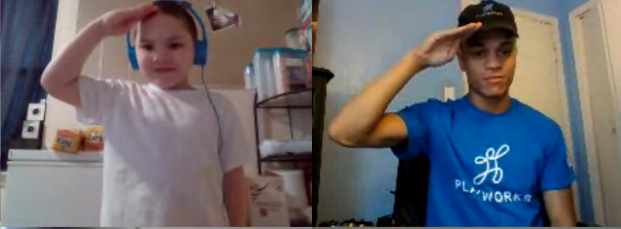The way that we play has changed.
Before the pandemic, we could observe the visual and auditory cues of children playing outside. We would see Ro Sham Bo (rock, paper, scissors) being used for conflict resolution and listen for the familiar scattered sounds of kids playing with each other. When most of the country shifted to virtual learning, those cues are a little more difficult to detect. And yet, we have seen that children, as resilient as ever, are able to adapt right along with us. At the beginning of the school year, we realized how important being up-front and intentional about teaching valuable skills would be for our students. Since they would almost entirely miss real-world lessons learned through kinetic play, we chose to focus on figuring out how to teach these skills virtually.
We know how beneficial play is.
Healthy play can improve children’s abilities to get along with others, regulate emotions; manage stress; and develop math, language, and motor skills. You name it, play helps it. We often play an engaging series of games, both movement and non-movement based, framed by specific skills that we plan in advance.
In one particular all-virtual school, when the students hear and have an opportunity to practice the skill that a specific game highlighted, they were often able to make real-world connections with the skill when debriefing the activity. While leading. Sometimes you have to make on-the-spot decisions in a strategic way to build engagement and move the game along. This skill is not something that coaches, teachers, or parents necessarily think about… but our children do. Some games require the audience to match the leader with a color or a movement. Some students had a hard time choosing a color. One thing that is often overlooked when teaching about choices, is the skill of being okay with the choices you make. To help kids build confidence, we came up with a game that combines a Playworks favorite, Alligator Swamp Trail, with MadLibs. The game was designed to be interactive and give students a chance to make quick decisions that would influence the rest of the game.
This game looks to help reinforce that skill.
Were students engaged through the game? Yes.
Did we notice more confident students as the weeks progressed while we played it? Definitely.
Did we observe students utilize their confidence to lead engaging games with their peers? Absolutely.
But more things happened also. Students who we have never met outside of a Google Classroom were fumbling to come off of mute at the end of our sessions to tell us that this was their favorite time of the week. We saw the same students electively coming week after week to play with us. We understand that the appeal is high to play fun games on the computer with familiar school faces, but practicing skills became possible because we fostered a learning environment based in play that they felt comfortable coming to every week. That made it special.
As you might be in need of new ideas, we want to share this game with you.
It has the potential to be both universal and sustainable. Teachers can create their own script based on what their class is studying at any given time. This activity is best suited for younger grades, but we challenge you to get creative and try it out with intermediate classes also. Teachers with science curriculums can create stories based on space exploration, ecosystems, weather, and geology. If you’re teaching social studies you can create a script based on historical figures or events. The opportunities for success with this game are endless.
Utilizing resources and games like these are ways to show your classroom communities that play is a priority. When we prioritize play for our students it can create positive and dynamic changes in learning behaviors. We hope that you can use this activity to promote confident decision-making skills through creative problem solving, all while having the best time with your students!

